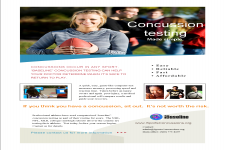Forces that Fracture
- Created on Tuesday, 02 August 2011 10:53
- Last Updated on 11.07.2012
- Published Date
ANN ARBOR, Mich.—While studying concussions in a high school football team, researchers captured the impact of an 18-year-old player who broke his neck during a head-down tackle in real-time.
Steven Broglio, an assistant professor in the University of Michigan School of Kinesiology, studies concussive impacts. His lab is the high school football field. The injured student in the study in Illinois healed and was cleared 12 weeks later to play basketball, Broglio said.
Though other researchers have captured concussion impact data in humans, this is believed to be the first time these data have been captured for a spinal fracture. The data appears July 20 in a letter in the New England Journal of Medicine.
It is rare for a high school or college student to suffer a broken neck; the bigger, more common problem in youth athletics is concussion. However, most of the media attention and research has focused on professional sports, Broglio said.
"To us, the larger public health issue is with the 1.5 million high school kids that play football each year. Not the 1,500 that play in the NFL," Broglio said.
The student-athletes in Broglio's study wear helmets outfitted with padded sensors called the Head Impact Telemetry System. The HITS uses the same type of sensor that activates a car air bag and wirelessly transmits the location and magnitude of that impact to a sideline computer 10-20 seconds later.
Eventually, Broglio would like to see a similar system used as diagnostic tool to record linear acceleration, rotational acceleration and impact location on every athletic field.
"Ultimately, we're trying to use these measures to predict concussion," Broglio said. "If someone exceeds a certain level then we would know they have a concussion and we could pull them." Broglio stresses that this technology is years away from becoming a reality.
In this particular player's case, it was obvious that something serious had occurred, Broglio said. However, the impact he sustained wasn't as hard as others have sustained in the four-year study who weren't concussed.
Researchers suspect each athlete's body reacts differently to impact, but the average for concussion is about the same across high school, college, and professional. A concussion occurs at roughly 90 to 100 g-force, "which is like smashing your head against a wall at 20 mph," Broglio said. The shuttle launch is about 3 g-force; a rolling fighter pilot about 5-10 g-force.
Broglio also found that a high school football player takes about 652 impacts over a 12-13 week season. "I challenge you to find a parent who will tell their kid to bang their head against the wall 652 times in 12 weeks," Broglio said. "It's an interesting way to think about it."
In the 120,000 impacts recorded over four years at Unity High School in Illinois, 25 were concussions and one a broken neck. Broglio was recently approved to continue the study at Skyline High School in Ann Arbor, Mich.
Co-authors include: Erik Swartz, University of New Hampshire; Joseph Crisco, Brown University; and Dr. Robert Cantu, Emerson Hospital.
The School of Kinesiology continues to be a leader in the areas of prevention and rehabilitation, the business of sport, understanding lifelong health and mobility, and achieving health across the lifespan through physical activity. It is home to the Athletic Training, Movement Science, Physical Education, and Sport Management academic programs, bringing together leaders in physiology, biomechanics, public health, urban planning, economics, marketing, public policy, and education and behavioral science.
Source: University of Michigan
Dr. Steven Broglio is a member of the SportsConcussions.org advisory board.
Questions/comments? Contact Jean Rickerson at This email address is being protected from spambots. You need JavaScript enabled to view it.
Brain Health
Children and young adults scanned multiple times by computed tomography (CT), a commonly used diagnostic tool, have a small increased risk of leukemia and brain tumors in the decade following their ...
read more...-
Why concussions affect people differently
Bronx, NY — Patients vary widely in their response to concussion, but scientists haven’t unde...
-
Teens miss recovery clues after concussion
PITTSBURGH — When recovering from concussion, young athletes rely too much on how they f...
-
Discovering the roots of migraine
Common questions encountered during the post-concussion exam are often migraine-related. Do you...




Neuroscience
NFL Hall of Famer "Iron Mike" Webster's life ended in 2002 when he suffered a heart attack at age 50. Four Super Bowl rings, nine Pro Bowls, and voted to the NFL's all-time team in 2000, the driven, ...
read more...-
Progesterone seems to protect neurons after injury
It is not yet known why girls suffer concussions at a higher rate than boys. The most prevalent...
-
911 signal relay sends help to brain injury
Like emergency workers rushing to a disaster scene, cells called microglia spe...
-
GPS for the brain; the "connectome"
Athens, Ga.- University of Georgia researchers have developed a map of the human brain that shows...
Resources
- School professionals play an important role in the health of all students. Recognizing the signs and symptoms of concussion is important, as is managing their return to school post-injury.
- Some ...
- https://
- CDC's Concussion Training for Clinicians
-
Concussion Education Video Programs - ...
Parents, athletes, coaches and medical professionals have access to concussion education created...
-
New concussion guidelines for team ...
INDIANAPOLIS – Team physicians who assess and treat athletes suspected of concussion have new ...
The risk of concussions in young football players
Marjorie Albohm President, National Athletic Trainers' Association
quick links
Latest News
Concussions Occur...
...in Any Sport
REMOVE athlete from play
REFER to medical provider
REST no sports, no texting/TV
RETURN only with doctor's OK
Source: Children's Hospital Boston, Sports Concussion Clinic
































